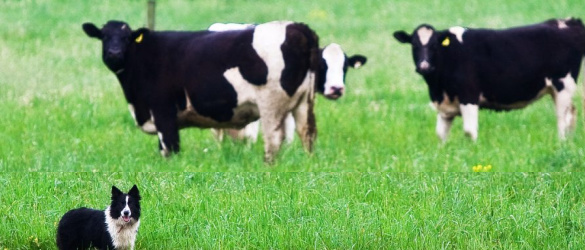
What is Neospora
What is Neospora?
Neospora Caninum is a protozoan parasite that is an important infectious cause of weak calves and abortion in cattle. It can affect other species including sheep, goats and camelids, however, these are thought to be less susceptible.
Neospora is the most frequently diagnosed cause of bovine abortion. A recent study done by Moredun showed 26% of aborted bovine foetuses were positive for Neospora Caninum.
How is it transmitted?
There are two ways that the parasite is transmitted:
Horizontally
Dogs and other wild canid species are the definitive hosts and shed infective oocysts in their faeces to the environment. The oocysts can survive for prolonged periods in water and soil, long after the faeces have decomposed. The cattle are intermediate hosts and become infected when consuming feed or water that is contaminated with oocysts from an infected dog. The dogs can become re-infected if they consume raw meat or placental tissue from infected cattle.
Vertically
From the dam to her foetus during pregnancy. This is the MAIN route of transmission. Once a cow/calf is infected with Neospora, they remain persistently infected for life. Persistently infected breeding dams will either consistently or intermittently pass the parasite across the placenta of their calves, hence infected dams are 3-7x more likely to abort in comparison to uninfected cattle. 95% of the calves born from positive dams are infected.
Clinical Signs
Clinical signs in the calves born from infected dams are mostly subclinical (i.e. no signs). Occasionally calves may be weak or have neurological deficits. In adult cattle the most obvious sign is abortion (3-8 months gestation); however, there are other economic impacts in lost time and production.
Diagnosis
• Submit aborted foetus and placenta (parasite can be detected in the brain, heart and skeletal muscles of the foetus)
• Blood sample the dam to test for antibody
• Blood sample the calf at less than 1 week old
• Rule out other causes of abortion
Advice
There is currently no vaccine or recognised licensed treatment for cattle.
• Reduce the risk of transmission by reducing contamination of feedstuffs and grazing areas by canine faeces (dog-proof feed stores, encouraging dog walkers to clean up after their dog if grazing land has public walkways etc)
• Deadstock and post-calving fluids/placenta should be disposed of rapidly in a manner that prevents the farm dogs from potentially ingesting any of it
• Herds with endemic neosporosis abortions may consider not retaining heifer calves born to seropositive cows, (reducing the number of congenitally infected replacement heifers that enter the breeding herd). In dairy cows seropositive dams can be bred to beef semen
• For seropositive cows with valuable genetics, the use of embryo transfer to Neospora – seronegative surrogates, a technique that blocks endogenous transmission, can be considered.
Article kindly supplied by Westpoint Farm Vets - www.westpointfarmvets.co.uk/neospora
The Cattle Information Service (CIS) Health Testing Service
A milk, blood or tissue sample holds a wealth of health information for dairy herds and the CIS disease testing will detect Neospora and other diseases which includes Johne’s, BVD Ab, BVD Ag, IBR Ab, IBR gE Ab, Lepto, Liver Fluke and Schmallenberg. Read more..
Watch the CIS Neospora Webinar
